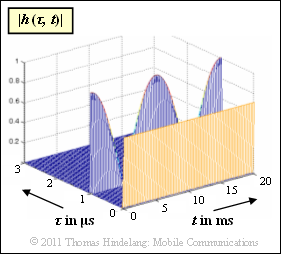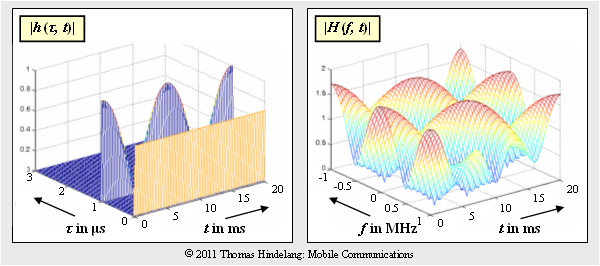Aufgaben:Aufgabe 2.4: 2D-Übertragungsfunktion: Unterschied zwischen den Versionen
| Zeile 47: | Zeile 47: | ||
===Musterlösung=== | ===Musterlösung=== | ||
{{ML-Kopf}} | {{ML-Kopf}} | ||
| − | '''(1)''' | + | '''(1)''' Die Periodendauer kann man aus der gegebenen Gleichung bestimmen. Berücksichtigt man die Betragsdarstellung, so ergibt sich $T_0 \ \underline {= 20 \ \rm ms}$. |
| − | '''(2)''' | + | |
| − | '''(3)''' | + | |
| − | '''(4)''' | + | '''(2)''' Zum Zeitpunkt $t_1 \ \underline {= 5 \ \rm ms}$ ist $h(\tau = 1 \ {\rm \mu s}, t_1) = 0$. Dementsprechend gilt |
| − | + | :$$h(\tau = 1\,{\rm \mu s},\hspace{0.05cm}t_1) = \frac{1}{ \sqrt{2}} \cdot \delta(\tau)\hspace{0.3cm}\Rightarrow \hspace{0.3cm} | |
| + | H(f,\hspace{0.05cm}t_1) = \frac{1}{ \sqrt{2}} = {\rm const.}$$ | ||
| + | |||
| + | Ebenso gilt für $t_2 \ \underline {15 ms}$: | ||
| + | :$$h(\tau = 1\,{\rm \mu s},\hspace{0.05cm}t_2) = \frac{1}{ \sqrt{2}} \cdot \delta(\tau)\hspace{0.3cm}\Rightarrow \hspace{0.3cm} | ||
| + | H(f,\hspace{0.05cm}t_2) = \frac{1}{ \sqrt{2}} = {\rm const.}$$ | ||
| + | |||
| + | |||
| + | '''(3)''' Zum Zeitpunkt $t = 0$ lautet die Impulsantwort mit $\tau_1 = 1 \ \rm \mu s$: | ||
| + | :$$h(\tau,\hspace{0.05cm}t = 0) = \frac{1}{ \sqrt{2}} \cdot \delta(\tau)+ \delta(\tau - \tau_1)\hspace{0.05cm}.$$ | ||
| + | |||
| + | Die Fouriertransformation führt zum Ergebnis: | ||
| + | :$$H_0(f) = H(f,\hspace{0.05cm}t = 0) \hspace{-0.1cm} \ = \ \hspace{-0.1cm} \frac{1}{ \sqrt{2}} + 1 \cdot {\rm exp}(- {\rm j}\cdot 2 \pi f \tau_1)=$$ | ||
| + | :$$\hspace{-0.1cm} \ = \ \hspace{-0.1cm} \frac{1}{ \sqrt{2}} + \cos( 2 \pi f \tau_1)- {\rm j}\cdot \sin( 2 \pi f \tau_1)$$ | ||
| + | :$$\Rightarrow \hspace{0.3cm} |H_0(f)| \hspace{-0.1cm} \ = \ \hspace{-0.1cm} | ||
| + | \sqrt { \left [ {1}/{ \sqrt{2}} + \cos( 2 \pi f \tau_1) \right ]^2 + \left [\sin( 2 \pi f \tau_1)\right ]^2}=$$ | ||
| + | :$$\hspace{-0.1cm} \ = \ \hspace{-0.1cm} | ||
| + | \sqrt { 0.5 + 1 + {2}/{ \sqrt{2}} \cdot \cos( 2 \pi f \tau_1)} = \sqrt { 1.5 + { \sqrt{2}} \cdot \cos( 2 \pi f \tau_1)}\hspace{0.05cm}.$$ | ||
| + | |||
| + | Daraus folgt: | ||
| + | * $H_0(f)$ ist periodisch mit $1/\tau_1 = 1 \ \rm MHz$. | ||
| + | * Für den Maximalwert bzw. Minimalwert gilt: | ||
| + | :$${\rm Max}\, \left [ \, |H_0(f)|\, \right ] \hspace{-0.1cm} \ = \ \hspace{-0.1cm} \sqrt { 1.5 + { \sqrt{2}} } \approx 1.707 \hspace{0.05cm},$$ | ||
| + | :$${\rm Min}\, \left [ \, |H_0(f)|\, \right ] \hspace{-0.1cm} \ = \ \hspace{-0.1cm} \sqrt { 1.5 - { \sqrt{2}} } \approx 0.293 \hspace{0.05cm}. $$ | ||
| + | * Bei $f = 0$ hat $|H_0(f)$ ein Maximum. | ||
| + | |||
| + | Richtig sind demzufolge <u>alle drei Lösungsvorschläge</u>. | ||
| + | |||
| + | |||
| + | '''(4)''' Für den Zeitpunkt $t = 10 \ \rm ms$ gelten folgende Gleichungen: | ||
| + | :$$h(\tau,\hspace{0.05cm}t = 10\,{\rm ms}) \hspace{-0.1cm} \ = \ \hspace{-0.1cm} \frac{1}{ \sqrt{2}} \cdot \delta(\tau)- \delta(\tau - \tau_1)\hspace{0.05cm},$$ | ||
| + | :$$H_{10}(f) = H(f,\hspace{0.05cm}t = 10\,{\rm ms}) \hspace{-0.1cm} \ = \ \hspace{-0.1cm} | ||
| + | \frac{1}{ \sqrt{2}} - \cos( 2 \pi f \tau_1)+ {\rm j}\cdot \sin( 2 \pi f \tau_1)\hspace{0.05cm},$$ | ||
| + | :$$ |H_{10}(f)| \hspace{-0.1cm} \ = \ \hspace{-0.1cm} | ||
| + | \sqrt { 1.5 - { \sqrt{2}} \cdot \cos( 2 \pi f \tau_1)}\hspace{0.05cm}.$$ | ||
| + | |||
| + | Die Frequenzperiode ändert sich gegenüber $t = 0$ nicht. Der Maximalwert ist weiterhin $1.707$ und auch der Minimalwer $0.293$ ändert sich nicht gegenüber der Teilaufgabe (3). Bei $f = 0$ tritt nun allerdings ein Minimum und kein Maximum auf ⇒ Richtig sind die <u>Lösungsvorschläge 1 und 2</u>. | ||
| + | |||
| + | Die rechte Grafik zeigt den Betrag $|H(f, t)|$ der zweidimensionalen Übertragungsfunktion. | ||
| + | |||
| + | [[Datei:P_ID2163__Mob_A_2_4d.png|center|frame|2D–Übertragungsfunktion |<i>H</i>(<i>f</i>, <i>t</i>)|]] | ||
{{ML-Fuß}} | {{ML-Fuß}} | ||
Version vom 19. November 2017, 12:08 Uhr
Dargestellt ist die zweidimensionale Impulsantwort $h(\tau, t)$ eines Mobilfunksystems in Betragsdarstellung. Es ist zu erkennen, dass die 2D–Impulsantwort nur für die Verzögerungszeiten $\tau = 0$ und $\tau = 1 \ \rm \mu s$ Anteile besitzt. Zu diesen Zeitpunkten gilt:
- $$h(\tau = 0\,{\rm \mu s},\hspace{0.05cm}t) \hspace{-0.1cm} \ = \ \hspace{-0.1cm} \frac{1}{ \sqrt{2}} = {\rm const.}$$
- $$h(\tau = 1\,{\rm \mu s},\hspace{0.05cm}t) \hspace{-0.1cm} \ = \ \hspace{-0.1cm} \cos(2\pi \cdot {t}/{ T_0})\hspace{0.05cm}.$$
Für alle anderen $\tau$–Werte ist $h(\tau, t) = 0$.
Gesucht ist die zweidimensionale Übertragungsfunktion $H(f, t)$ als die Fouriertransformierte von $h(\tau, t)$ hinsichtlich der Verzögerungszeit $\tau$:
- $$H(f,\hspace{0.05cm} t) \hspace{0.2cm} \stackrel {f,\hspace{0.05cm}\tau}{\bullet\!\!-\!\!\!-\!\!\!-\!\!\circ} \hspace{0.2cm} h(\tau,\hspace{0.05cm}t) \hspace{0.05cm}.$$
Hinweise:
- Die Aufgabe gehört zum Kapitel Mehrwegeempfang beim Mobilfunk.
- Eine ähnliche Problematik wird in der Aufgabe A2.5 behandelt, allerdings mit veränderter Nomenklatur.
Fragebogen
Musterlösung
(2) Zum Zeitpunkt $t_1 \ \underline {= 5 \ \rm ms}$ ist $h(\tau = 1 \ {\rm \mu s}, t_1) = 0$. Dementsprechend gilt
- $$h(\tau = 1\,{\rm \mu s},\hspace{0.05cm}t_1) = \frac{1}{ \sqrt{2}} \cdot \delta(\tau)\hspace{0.3cm}\Rightarrow \hspace{0.3cm} H(f,\hspace{0.05cm}t_1) = \frac{1}{ \sqrt{2}} = {\rm const.}$$
Ebenso gilt für $t_2 \ \underline {15 ms}$:
- $$h(\tau = 1\,{\rm \mu s},\hspace{0.05cm}t_2) = \frac{1}{ \sqrt{2}} \cdot \delta(\tau)\hspace{0.3cm}\Rightarrow \hspace{0.3cm} H(f,\hspace{0.05cm}t_2) = \frac{1}{ \sqrt{2}} = {\rm const.}$$
(3) Zum Zeitpunkt $t = 0$ lautet die Impulsantwort mit $\tau_1 = 1 \ \rm \mu s$:
- $$h(\tau,\hspace{0.05cm}t = 0) = \frac{1}{ \sqrt{2}} \cdot \delta(\tau)+ \delta(\tau - \tau_1)\hspace{0.05cm}.$$
Die Fouriertransformation führt zum Ergebnis:
- $$H_0(f) = H(f,\hspace{0.05cm}t = 0) \hspace{-0.1cm} \ = \ \hspace{-0.1cm} \frac{1}{ \sqrt{2}} + 1 \cdot {\rm exp}(- {\rm j}\cdot 2 \pi f \tau_1)=$$
- $$\hspace{-0.1cm} \ = \ \hspace{-0.1cm} \frac{1}{ \sqrt{2}} + \cos( 2 \pi f \tau_1)- {\rm j}\cdot \sin( 2 \pi f \tau_1)$$
- $$\Rightarrow \hspace{0.3cm} |H_0(f)| \hspace{-0.1cm} \ = \ \hspace{-0.1cm} \sqrt { \left [ {1}/{ \sqrt{2}} + \cos( 2 \pi f \tau_1) \right ]^2 + \left [\sin( 2 \pi f \tau_1)\right ]^2}=$$
- $$\hspace{-0.1cm} \ = \ \hspace{-0.1cm} \sqrt { 0.5 + 1 + {2}/{ \sqrt{2}} \cdot \cos( 2 \pi f \tau_1)} = \sqrt { 1.5 + { \sqrt{2}} \cdot \cos( 2 \pi f \tau_1)}\hspace{0.05cm}.$$
Daraus folgt:
- $H_0(f)$ ist periodisch mit $1/\tau_1 = 1 \ \rm MHz$.
- Für den Maximalwert bzw. Minimalwert gilt:
- $${\rm Max}\, \left [ \, |H_0(f)|\, \right ] \hspace{-0.1cm} \ = \ \hspace{-0.1cm} \sqrt { 1.5 + { \sqrt{2}} } \approx 1.707 \hspace{0.05cm},$$
- $${\rm Min}\, \left [ \, |H_0(f)|\, \right ] \hspace{-0.1cm} \ = \ \hspace{-0.1cm} \sqrt { 1.5 - { \sqrt{2}} } \approx 0.293 \hspace{0.05cm}. $$
- Bei $f = 0$ hat $|H_0(f)$ ein Maximum.
Richtig sind demzufolge alle drei Lösungsvorschläge.
(4) Für den Zeitpunkt $t = 10 \ \rm ms$ gelten folgende Gleichungen:
- $$h(\tau,\hspace{0.05cm}t = 10\,{\rm ms}) \hspace{-0.1cm} \ = \ \hspace{-0.1cm} \frac{1}{ \sqrt{2}} \cdot \delta(\tau)- \delta(\tau - \tau_1)\hspace{0.05cm},$$
- $$H_{10}(f) = H(f,\hspace{0.05cm}t = 10\,{\rm ms}) \hspace{-0.1cm} \ = \ \hspace{-0.1cm} \frac{1}{ \sqrt{2}} - \cos( 2 \pi f \tau_1)+ {\rm j}\cdot \sin( 2 \pi f \tau_1)\hspace{0.05cm},$$
- $$ |H_{10}(f)| \hspace{-0.1cm} \ = \ \hspace{-0.1cm} \sqrt { 1.5 - { \sqrt{2}} \cdot \cos( 2 \pi f \tau_1)}\hspace{0.05cm}.$$
Die Frequenzperiode ändert sich gegenüber $t = 0$ nicht. Der Maximalwert ist weiterhin $1.707$ und auch der Minimalwer $0.293$ ändert sich nicht gegenüber der Teilaufgabe (3). Bei $f = 0$ tritt nun allerdings ein Minimum und kein Maximum auf ⇒ Richtig sind die Lösungsvorschläge 1 und 2.
Die rechte Grafik zeigt den Betrag $|H(f, t)|$ der zweidimensionalen Übertragungsfunktion.

